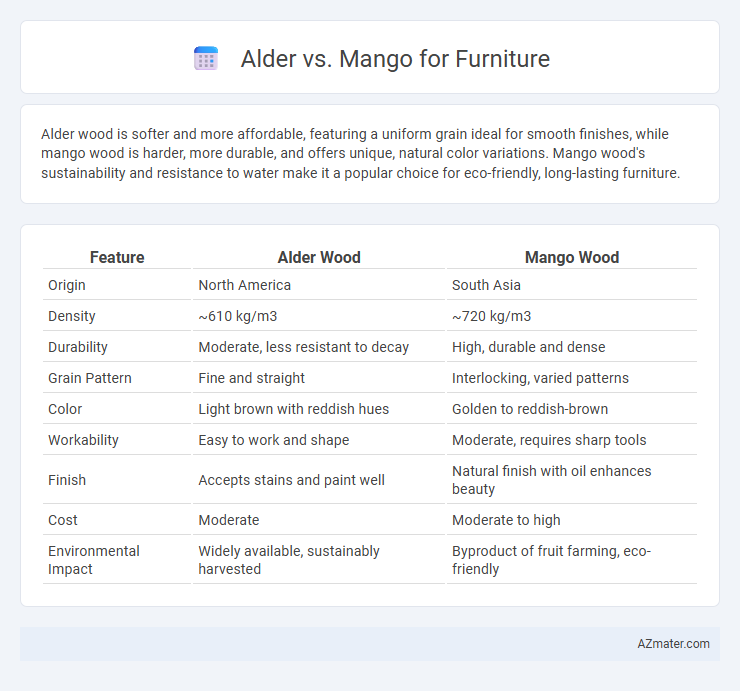Alder wood is softer and more affordable, featuring a uniform grain ideal for smooth finishes, while mango wood is harder, more durable, and offers unique, natural color variations. Mango wood's sustainability and resistance to water make it a popular choice for eco-friendly, long-lasting furniture.
Table of Comparison
| Feature | Alder Wood | Mango Wood |
|---|---|---|
| Origin | North America | South Asia |
| Density | ~610 kg/m3 | ~720 kg/m3 |
| Durability | Moderate, less resistant to decay | High, durable and dense |
| Grain Pattern | Fine and straight | Interlocking, varied patterns |
| Color | Light brown with reddish hues | Golden to reddish-brown |
| Workability | Easy to work and shape | Moderate, requires sharp tools |
| Finish | Accepts stains and paint well | Natural finish with oil enhances beauty |
| Cost | Moderate | Moderate to high |
| Environmental Impact | Widely available, sustainably harvested | Byproduct of fruit farming, eco-friendly |
Overview of Alder and Mango Wood
Alder wood is a soft hardwood known for its smooth texture, light color, and excellent workability, making it popular in furniture crafting for a warm, natural finish. Mango wood, a sustainable hardwood sourced from the mango tree, offers a unique grain pattern with vibrant color variations and high durability, often used in eco-friendly and stylish furniture designs. Both woods provide versatility but differ in hardness, grain, and sustainability, influencing their suitability for different furniture styles and uses.
Origin and Sustainability
Alder wood, primarily sourced from the Pacific Northwest of the United States, is known for its sustainable harvesting practices due to fast growth and responsible forest management. Mango wood originates from South Asia, particularly India, and is considered eco-friendly as it repurposes wood from mango trees that no longer bear fruit. Both woods offer sustainable options for furniture, with alder's renewable sourcing and mango's utilization of agricultural byproducts ensuring environmental responsibility.
Physical Characteristics
Alder wood features a fine, straight grain with a smooth texture and a light brown to reddish hue, making it ideal for rustic or casual furniture styles. Mango wood is denser and harder, displaying a unique grain pattern with rich golden to dark brown streaks that enhance its durability for heavy-use furniture pieces. Both woods resist warping, but mango's higher density contributes to superior strength and longevity in furniture construction.
Durability and Strength
Alder wood offers moderate durability and strength, making it suitable for lightweight furniture with smooth finishes, but it is more prone to dents and scratches compared to hardwoods. Mango wood, known for its dense grain and natural hardness, provides superior strength and durability, ideal for heavy-use furniture pieces requiring long-lasting support. Both woods are sustainable options, but mango's resilience against wear makes it preferable for robust furniture designs.
Workability and Ease of Crafting
Alder wood offers excellent workability due to its soft texture and uniform grain, making it ideal for intricate furniture designs and detailed carving. Mango wood, while slightly harder, provides good ease of crafting with its fine, interlocked grain that resists splitting and warping during construction. Both woods are preferred in furniture making, but alder is often favored for projects requiring high precision and smooth finishes.
Aesthetic Appeal and Grain Patterns
Alder wood offers a warm, reddish-brown hue with fine, straight grain patterns that create a smooth, consistent aesthetic ideal for rustic and traditional furniture designs. Mango wood showcases a richer color palette ranging from creamy yellow to dark brown with unique swirling grain patterns and occasional knots, adding a vibrant, exotic appeal to contemporary furniture pieces. Both woods provide distinctive visual textures, with alder lending subtle elegance and mango delivering bold, artistic character.
Cost Comparison
Alder wood furniture typically costs less than mango wood due to its faster growth rate and wider availability, making it a budget-friendly option for consumers. Mango wood furniture, while often priced higher, is valued for its durability and unique grain patterns, which can justify the increased investment. Cost differences between alder and mango furniture generally reflect regional supply and demand, with alder favored for economical projects and mango preferred for distinctive, long-lasting pieces.
Maintenance and Care
Alder wood furniture requires regular sealing or finishing to prevent dents and scratches due to its softer grain, while Mango wood offers greater durability and is naturally resistant to moisture and decay, making it easier to maintain. Cleaning alder involves gentle dusting and avoiding harsh chemicals to preserve its smooth surface, whereas mango wood benefits from occasional polishing with natural oils to enhance its rich color and prevent drying. Both materials respond well to proper care, but mango furniture generally demands less frequent maintenance compared to alder.
Best Uses in Furniture Design
Alder wood offers a smooth texture and warm, reddish-brown tones ideal for rustic and traditional furniture styles, excelling in cabinetry, dressers, and carved pieces due to its softness and ease of shaping. Mango wood features a denser grain with rich, varied hues ranging from light to dark brown, making it highly durable and suitable for contemporary furniture such as dining tables, chairs, and decorative shelving. Both woods provide unique aesthetic and functional qualities, with alder favored for detailed craftsmanship and mango prized for strength and resistance to wear.
Pros and Cons of Alder vs Mango Wood
Alder wood offers a smooth texture, light color, and ease of staining, making it popular for furniture that requires a refined and uniform finish; however, it is softer and less durable compared to hardwoods, making it prone to dents and scratches. Mango wood is dense, durable, and boasts a distinctive grain pattern with eco-friendly credentials, as it is harvested from deciduous trees that have finished fruit production, but its uneven grain and color variations can be challenging for consistent staining and finishing. Both woods provide cost-effective alternatives for stylish furniture, with Alder favored for indoor, finely finished pieces and Mango preferred for rustic, sustainable designs requiring robust construction.

Infographic: Alder vs Mango for Furniture
 azmater.com
azmater.com